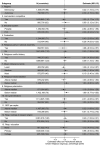Election cycles and global religious intolerance
- PMID: 36580598
- PMCID: PMC9910473
- DOI: 10.1073/pnas.2213198120
Election cycles and global religious intolerance
Abstract
Mass elections are key mechanisms for collective decision-making. But they are also blamed for creating intergroup enmity, particularly while they are underway; politicians use polarizing campaign strategies, and losing sides feel resentful and marginalized after results are announced. I investigate the impact of election proximity-that is, closeness to elections in time-on social cleavages related to religion, a salient form of group identity worldwide. Integrating data from ∼1.2 million respondents across 25 cross-country survey series, I find no evidence that people interviewed shortly before or after national elections are more likely to express negative attitudes toward religious outgroups than those interviewed at other times. Subgroup analysis reveals little heterogeneity, including by levels of political competition. Generalized social trust, too, is unaffected by election calendars. Elections may not pose as great a risk to social cohesion as is commonly feared.
Keywords: elections; intolerance; political science; prejudice; religion.
Conflict of interest statement
The author declares no conflict of interest.
Figures




References
-
- Mill J. S., Considerations on Representative Government (Parker, Son, and Bourn, 1861).
-
- Schumpeter J. A., Capitalism, Socialism and Democracy (Harper and Brothers, 1942).
-
- Fukuyama F., Political Order and Political Decay: From the Industrial Revolution to the Globalization of Democracy (Farrar, Straus and Giroux, 2014).
-
- Matanock A. M., Electing Peace: From Civil Conflict to Political Participation (Cambridge University Press, 2017).
-
- Riker W. H., The Theory of Political Coalitions (Yale University Press, 1962).
MeSH terms
LinkOut - more resources
Full Text Sources

